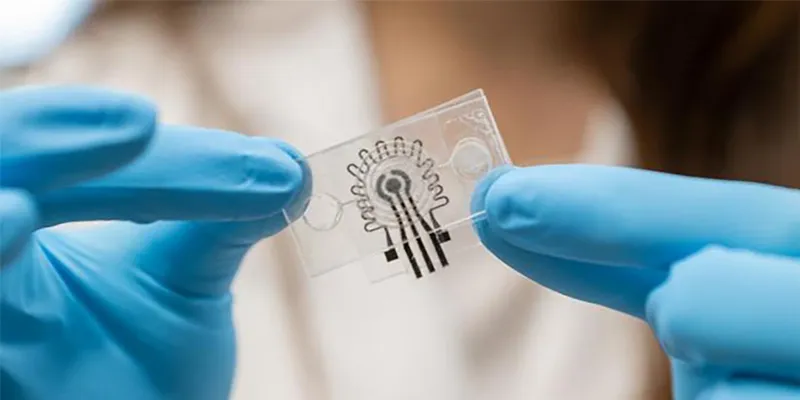Revolutionary Wearable Sensor Can Monitor Vital Health Data in Real-Time

6 October 2023
In a groundbreaking development, researchers from Penn State University have unveiled a novel wearable patch capable of continuously analyzing sweat for up to three weeks. This innovative device, made from a laser-modified graphene nanocomposite material, can detect specific glucose levels while simultaneously monitoring body temperature and pH levels.
As the world moves towards non-invasive methods for health monitoring, this wearable patch stands out as a beacon of innovation, promising a future where tracking our health could be as simple as wearing a stamp-sized device.
Sweat, often overlooked, is a goldmine of information about our health, particularly concerning glucose levels. Continuous sweat monitoring can provide crucial insights into human health, like glucose levels.
Sweat is ideal for real-time, continuous and noninvasive biomarker detection. But low biomarker concentration levels in sweat and variability of other factors such as pH, salinity and temperature have pushed previous sweat biosensors past the limits of their detection and accuracy. This device is able to account for this variability while measuring glucose with needed specificity for weeks at a time,” said Huanyu Cheng, the article's writer and Associate Professor of Engineering Science and Mechanics (ESM) at Penn State.
Addressing these challenges, Cheng's team turned to laser-induced graphene (LIG) electrodes. These electrodes, known for their simplicity, affordability, and flexibility, were enhanced using a unique laser treatment. This treatment created a stable, 3D network of highly conductive noble metal alloys, specifically gold and silver, combined with carbon-based nanocomposite materials. The result? A sensor resistant to oxidation and agglomeration, ensuring a larger surface area for accurate readings.
“Glucose on the surface of the modified LIG electrode oxidizes at lower potential. This oxidation generates a measurable current or potential change that is directly proportional to the overall glucose concentration in the solution. We also see far greater stability over time, with the laser-treated sensor,” said the study's first author Farnaz Lorestani, ESM postdoctoral scholar.
The wearable patch, roughly twice the width of a postage stamp, is designed for convenience. It adheres to the skin with adhesive tape and wirelessly transmits data to computers or mobile devices for real-time monitoring and analysis. This continuous monitoring, calibrated by simultaneously measured pH and temperature, offers a more accurate picture of glucose levels, especially during activities like exercise or eating.
Cheng envisions a bright future for the device. "It is a low-cost platform offering convenient, accurate, and continual analysis of sweat in diverse conditions," he said, emphasizing its potential in personalized medicine, precision nutrition, and broader health monitoring.
The research, published in the journal Advanced Functional Materials, was a collaborative effort involving multiple scholars from Penn State's Engineering Science and Mechanics department and the Penn State Materials Research Institute. Funding for this groundbreaking work was provided by the National Institutes of Health and the National Science Foundation.
Abstract of the research
A Highly Sensitive and Long-Term Stable Wearable Patch for Continuous Analysis of Biomarkers in Sweat
Abstract: Although increasing efforts have been devoted to the development of non-invasive wearable electrochemical sweat sensors for monitoring physiological and metabolic information, most of them still suffer from poor stability and specificity over time and fluctuating temperatures. This study reports the design and fabrication of a long-term stable and highly sensitive flexible electrochemical sensor based on nanocomposite-modified porous graphene by facile laser treatment for detecting biomarkers such as glucose in sweat. The laser-reduced and patterned stable conductive nanocomposite on the porous graphene electrode provides the resulting glucose sensor with an excellent sensitivity of 1317.69 µA mm−1 cm−2 and an ultra-low limit of detection of 0.079 µm. The sensor can also detect pH and exhibit extraordinary stability to maintain more than 91% sensitivity over 21 days in ambient conditions. Taken together with a temperature sensor based on the same material system, the dual glucose and pH sensor integrated with a flexible microfluidic sweat sampling network further results in accurate continuous on-body glucose detection calibrated by the simultaneously measured pH and temperature. The low-cost, highly sensitive, and long-term stable platform could facilitate the early identification and continuous monitoring of different biomarkers for non-invasive disease diagnosis and treatment evaluation.











Comments
No Comments Yet!